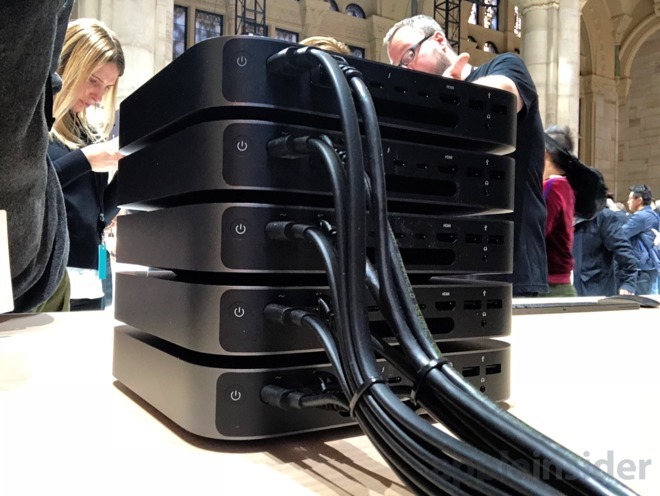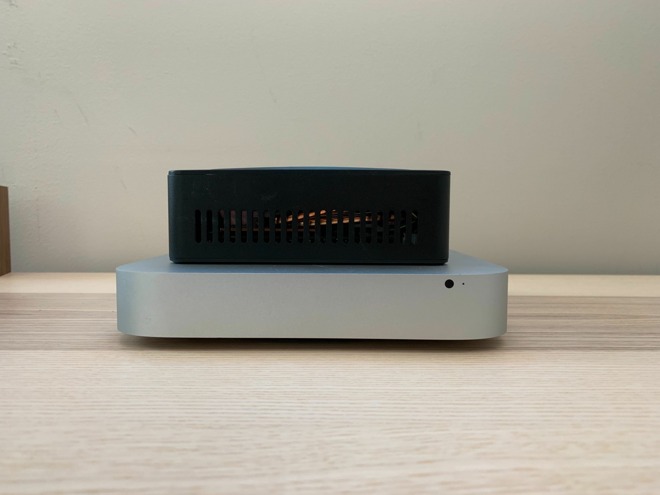Apple's 'modular' Mac Pro design may mean units that connect like Lego bricks
A new report claims that the Mac Pro refresh will rely on a custom data connector, and mission-specific modules that can be stacked to provide what users need -- but also that it may not ship to customers until 2020.

How the current Mac mini is already being used as a stackable system of sorts
YouTube channel Tailosive Tech has released a video that claims in-depth details of the new Mac Pro which are reportedly based on information from sources within Apple. The main news is that the Mac Pro is to come as a series of stackable modules, each only slightly bigger than the current Mac mini, letting customers choose the configurations they need.
"What my personal insider sources told me is that the Mac Pro in the sense of modular, is a stacking system [as] opposed to a computer case with parts on the inside and door that opens up," says the presenter on Tailosive Tech. "There's multiple modules you can buy when you getting the Mac Pro. The only one you have to buy is the brain module which is supposedly a little bulkier than the standard Mac mini."
"It has some ports on it and it mostly houses the RAM and the CPU," he adds. "But Apple has already made its own proprietary connectors that are placed on top of this brain module and this will allow you to buy different modules that have I/O, that have GPUs, extra storage."
Tailosive also claims that while the Mac Pro will be unveiled this year, it may not actually ship until 2020. This is not entirely dissimilar to the 2013 Mac Pro, which shipped in profoundly limited quantities in the year it was released. When it did ship, it was only in the last few days of the year, allowing Apple to say that it hit the 2013 deadline it set for itself.
As for the details of how each module in stack will work, Tailosive Tech claims to know that they will be powered from the base or 'brain' module but feature independent power supplies and cooling.
"What it results in is ultimate customizability," he says. "So if a professional out there just wants a Mac Pro because it's a small device, they don't need to spend all that money on an iMac Pro..., they'll be able to buy just the brain module. But those people out there who really need that graphics processing, they'll be able to buy one, two, perhaps three or four different GPU modules and stack it on their Mac Pro however they want to stack it."

Sonnet RX 570 eGPU puck on top of an existing Mac mini
This isn't the first time that this rumor has surfaced. In previous incarnations of the speculation, it was suspected that the modules would work for RAM as well.
The existing Thunderbolt 3 connection is in essence a PCI-E 3.0 x4 connection to a peripheral. In order for the system to work for RAM, the connector would not just have to diverge from Thunderbolt, but make major architectural changes to how it communicates to the system as well.
Because of those architectural changes, it isn't clear how routinely swappable they will be. A connector allowing for RAM expansion would need a high-speed -- and not hot-swappable -- bus to connect with the CPU.
Apple has executed the concept of a custom high-speed data connector in a rudimentary fashion before. The PowerBook Duo system from the '90s had a custom connector, which allowed for a wide array of expansion for a docked computer -- but it did not have a bus speed suitable for RAM expansion.
While Apple has not commented on this report nor offered any detail of its plans, the company has gone out of its way three times to specify that the new Mac Pro will be "modular". It has also noticeably shied away from saying it will use PCI-E on the multiple occasions that it has talked about the hardware.
Other sources including analyst Ming-Chi Kuo have claimed information about the forthcoming design which don't confirm those of Tailosive Tech but don't contradict it, either.

How the current Mac mini is already being used as a stackable system of sorts
YouTube channel Tailosive Tech has released a video that claims in-depth details of the new Mac Pro which are reportedly based on information from sources within Apple. The main news is that the Mac Pro is to come as a series of stackable modules, each only slightly bigger than the current Mac mini, letting customers choose the configurations they need.
"What my personal insider sources told me is that the Mac Pro in the sense of modular, is a stacking system [as] opposed to a computer case with parts on the inside and door that opens up," says the presenter on Tailosive Tech. "There's multiple modules you can buy when you getting the Mac Pro. The only one you have to buy is the brain module which is supposedly a little bulkier than the standard Mac mini."
"It has some ports on it and it mostly houses the RAM and the CPU," he adds. "But Apple has already made its own proprietary connectors that are placed on top of this brain module and this will allow you to buy different modules that have I/O, that have GPUs, extra storage."
Tailosive also claims that while the Mac Pro will be unveiled this year, it may not actually ship until 2020. This is not entirely dissimilar to the 2013 Mac Pro, which shipped in profoundly limited quantities in the year it was released. When it did ship, it was only in the last few days of the year, allowing Apple to say that it hit the 2013 deadline it set for itself.
As for the details of how each module in stack will work, Tailosive Tech claims to know that they will be powered from the base or 'brain' module but feature independent power supplies and cooling.
"What it results in is ultimate customizability," he says. "So if a professional out there just wants a Mac Pro because it's a small device, they don't need to spend all that money on an iMac Pro..., they'll be able to buy just the brain module. But those people out there who really need that graphics processing, they'll be able to buy one, two, perhaps three or four different GPU modules and stack it on their Mac Pro however they want to stack it."

Sonnet RX 570 eGPU puck on top of an existing Mac mini
This isn't the first time that this rumor has surfaced. In previous incarnations of the speculation, it was suspected that the modules would work for RAM as well.
The existing Thunderbolt 3 connection is in essence a PCI-E 3.0 x4 connection to a peripheral. In order for the system to work for RAM, the connector would not just have to diverge from Thunderbolt, but make major architectural changes to how it communicates to the system as well.
Because of those architectural changes, it isn't clear how routinely swappable they will be. A connector allowing for RAM expansion would need a high-speed -- and not hot-swappable -- bus to connect with the CPU.
Apple has executed the concept of a custom high-speed data connector in a rudimentary fashion before. The PowerBook Duo system from the '90s had a custom connector, which allowed for a wide array of expansion for a docked computer -- but it did not have a bus speed suitable for RAM expansion.
While Apple has not commented on this report nor offered any detail of its plans, the company has gone out of its way three times to specify that the new Mac Pro will be "modular". It has also noticeably shied away from saying it will use PCI-E on the multiple occasions that it has talked about the hardware.
Other sources including analyst Ming-Chi Kuo have claimed information about the forthcoming design which don't confirm those of Tailosive Tech but don't contradict it, either.




Comments
http://oldcomputers.net/ti994a.html
H-P offers a somewhat modular compact desktop with different plug-in modules connecting through a USB connector. The Elite Slice has been on sale for a couple of years.
I do not know if the report is correct, but Apple has a long history of proprietary connectors used to lock customers in.
The convenience of the stackable modules is wholly out of whack with how often you'll need to be modifying the stack, and would cause huge downstream problems that are way, way more detrimental than convenience.
Form over function to the nth degree.
The Cheesegrater design is still today a marvel of smart engineering. A slightly smaller version adapted for SSDs instead of conventional HDs and a single slot for an optional Blu-Ray drive would be wonderful. My 2010 is still a beast at many tasks but has as a practical matter reached the end of the road. I had to replace the power supply a couple of years ago and doubt I would spend that kind of money on it again.
If Apple would stop trying to be a fashion house and start making a workstation they might be able to sell some hardware. I would order one as soon as I saw it and verified it was a decent piece of kit. I do not care about how skinny it is or some other fashion nonsense- it would be sitting under my desk where nobody would care what stylings Jony put on it. I can (kind of) understand the styling thing on a laptop or a desktop iMac, but a workstation grade computer is a tool- not an object of art.
There simply is no great reason to have a mess all over your desktop or a spaghetti bowl of wires as in the trashcan design. internal, user maintainable, upgradeable and using industry standard slots and connectors. It is not exactly rocket science. Tell Tim to ask Jon Rubenstein back to head the development- he is the guy who headed the team that did the Cheesegrater.
And while Apple is at it, how about an Apple Cinema Display that is 4 or 5 K about 32" with a widescreen aspect ratio?
What it is not for, is for the 5,1 Mac Pro user. This I know, because I am one.
Either way, I still own Apple products, but all my professional work has long since transferred to PC where I spend half as much, get three times more and am not constantly dissapointed.
Give us 4+ PCIe 3.0+ slots, 2+ M.2/NVMe slots, 2xCPU (or expansion to dual+), slots for 128GB+ RAM, 4+ USB 3/USB C, then throw in audio (optical and/or 3.5mm) and a PSU. Use some screws to hold in place and nothing should be glued. Call it a day. Seriously don't know what the delay or big deal needs to be... oh, right... that TB3 "thing" that can't handle x16 speeds and isn't even necessary on this kind of machine.